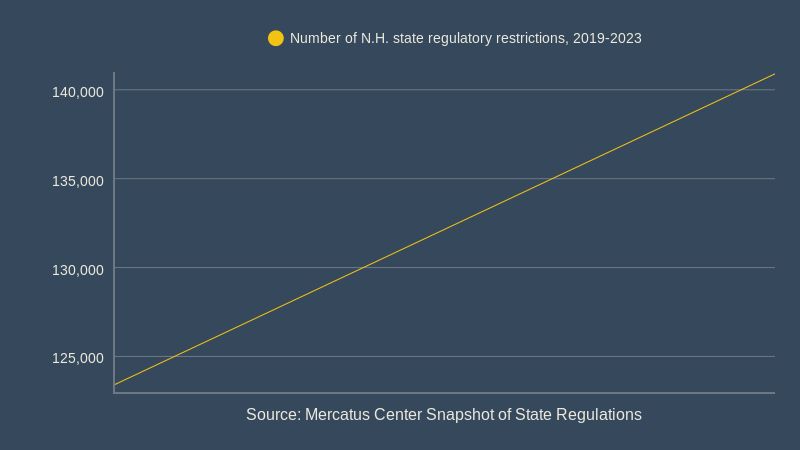New Hampshire is the freest state in the country and on the continent. But on some measures of economic freedom, we do poorly. Most Granite Staters would probably be surprised to learn that New Hampshire is in the top 20 most regulated states in the nation.
New Hampshire’s recent regulatory growth
Researchers at the Mercatus Center at George Mason University have tracked the growth of state regulations since 2019. New Hampshire ranks as the 18th most heavily regulated state. We are more heavily regulated than every other New England state save Massachusetts, which ranks 9th.
From 2019-2023, the number of state regulatory restrictions in New Hampshire grew by 14%, rising from 123,423 to 140,893, according to Mercatus’ tracking.

Policy areas in which New Hampshire’s regulations exceed national averages include:
- broadcasting
- health services
- environmental protection, public utilities and natural resources,
- taxes and public finance
While state policymakers have focused in recent years on aiding economic growth by lowering business tax rates, the state’s regulatory burden has grown steadily, likely countering some of the positive tax cut effects.
Cutting regulations can stimulate growth. The Canadian province of British Columbia did it successfully, starting in 2001 with a reform requiring two regulations to be cut for every new one added. The regulatory cuts flipped the state’s economic growth rate from lower than the national average to higher, a Mercatus Center study has shown.
Regulatory reform in other states
Several U.S. states offer ideas for how to reduce regulatory burdens:
- Ohio in 2022 required state agencies to cut regulations by 30% in three years. Agencies use an artificial intelligence program called Reg Explorer to identify regulations to eliminate, City Journal reports. The state expects to trim 5 million words, or 1/3 of its regulatory code, by mid-2025.
- Idaho Gov. Brad Little in 2019 issued two executive orders to slash state regulations. The Red Tape Reduction Act requires state rule-making agencies to eliminate two existing rules for every rule they pass. The Licensing Freedom Act puts sunsets on occupational licensing rules.
- Virginia Gov. Glenn Youngkin in 2022 issued an executive order establishing the Office of Regulatory Management to streamline the regulatory process and improve transparency.
- Utah has regulatory sandbox law that allows short-term waivers of state regulations. Its Office of Regulatory Relief administers the waivers.
- Arizona has a Governor’s Regulatory Review Council that reviews state rules for statutory compliance and cost burden. If a rule’s benefits don’t outweigh its costs, the council can reject it.
Rejecting the Massachusetts model
Gov-elect Kelly Ayotte has promised to keep New Hampshire from becoming Massachusetts. In the area of government regulations, New Hampshire has been creeping in Massachusetts’ direction. Taking swift action to reverse this regulatory growth would reduce state interference in the private sector and improve economic freedom without requiring any new state spending. Reducing state rules might even have the effect of trimming state spending, as fewer rules could mean fewer bureaucrats.
